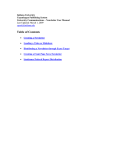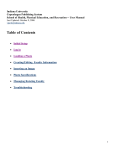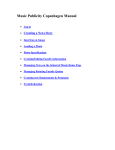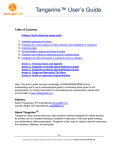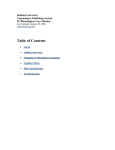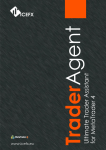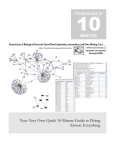Download IUPUI -- User Manual - OneStart
Transcript
Indiana University Copenhagen Publishing System IUPUI -- User Manual Last Updated: August 6, 2006 [email protected] Table of Contents • Initial Setup • Log in • Creating a News Story/Tip Sheet • Adding/changing distribution information • Inserting an Image • Creating a Spotlight • Creating a Video Spotlight • Creating an Expert Source • Managing the IUPUI News Center Home Page • Loading a Photo Asset • Loading a Video Asset • Photo Specifications • Distribution • Creating a New Group • Creating a New Topic • Creating an External News Link • Managing News Feeds on External Sites Initial Setup You need to have the java plug-in available from [http://www.indiana.edu/~vpurit/copenhagen.shtml] installed in order to view and edit body of the message. You need administrative rights to the computer in order to install the plug-in. Please add the following parameter to your java plug-in: Start => Settings => Java Plug-in => Advanced => Java Runtime Parameters field: -Djava.security.policy=http://newsinfo.iu.edu/policy/mrps.policy Log in Open browser, go to: http://info-p.iupui.edu/admin/ Creating a News Story/Tip Sheet 1. On the left side of the Copenhagen screen, you will see the Navigator Pane. The Navigator Pane contains a list of active folders. Select the Pages folder. (It is the default folder, so it may already be open.) 2. Click on the New command from the top of the screen. This will open the Page Editor window. 3. The Page Editor window has several sections. You can jump to each section by clicking on the Jump to links at the top of the Page Editor window. 4. In the General Information section, enter the Page Type. a. The Page Type for a news story is News Story. b. The Page Type for a tip sheet is Tipsheet. 5. Enter the Slug. This is the internal working title for your news story or tip sheet. This is a required field (required fields are red). 6. Enter the Title in the Body table. This is the official, published title for your news story or tip sheet. This is a required field. 7. Click the Save button. You must click Save in order to create a URL for your news story or tip sheet. The URL is automatically generated. 8. After you save, you will see a Pencil Icon in the Body box. Click on the Pencil Icon. 9. This opens the Composer window. This is where you will enter and edit the body of your news story or tip sheet. 10. Copy your document from Microsoft Word or another word processing program and paste it into the Composer text area. The Composer window is a What You See Is What You Get editor, meaning that whatever styles you apply to the text will be what you see on the Web. 11. Click the Save button to save the body of your news story or tip sheet. 12. Click the Close button to go back to the Page Editor window. 13. Next enter the Teaser Title in the Teaser table. Teaser title needs to be no more than 40-55 characters in length. 14. To create the teaser body, click on the Pencil Icon in the Teaser box. 15. Enter the teaser body in the Composer window. 16. Next position your cursor at the very beginning of the teaser body and insert a thumbnail photo or icon. (Please refer to the Inserting an Image section for specific instructions. Standard icons are located in the Icons folder within the Navigator Pane). 17. Click the Save button to save your teaser body and icon. 18. Click the Close button to go back to the Page Editor window. 19. Next, scroll down to the Contacts section. 20. Under Related Persons select related Faculty Experts (make sure they are published—indicated by a p: prefix). To select more than one Faculty Expert, hold down the Ctrl button on your keyboard while clicking on the names. 21. In the External Contacts table you can also enter up to four contacts per news story or tip sheet. The contacts are labeled External Contacts #1 through #4. 22. In the first field of External Contacts #1, select the Type of contact. Your options are Contact Information, Media Contacts, or Secretarial Contact. 23. Enter the Name of the contact. Use the contact’s full name in this field. 24. Enter the Title of the contact. 25. Enter the Phone, Fax, and E-mail Address information for the contact. 26. Click on the top link directly after and to the right of the external contacts table to go to the top of the Page Editor window. Click on the Save button to save your new story or tip sheet. 27. In the Keywords & Links section, enter search keywords in the Keywords text area. Keywords will help drive traffic to the news release based on search engine results (such as Google). 28. In the Related Links table, enter up to six related external websites. 29. In the Related Groups section, check all related groups (IU Schools, Departments, Institutes, etc.). 30. In the Related Topics section, check all related topics 31. Click on the top link directly after and to the right of the Related Topics table to go to the top of the Page Editor window. Click on the Save button to save your new story or tip sheet. 32. Finally, click the Check-in button. In the Change Document Status section, select Proposed in the drop-down list to submit the news story or tip sheet for editing. You can also send the news story or tip sheet for copy editing or review to a specific editor by selecting a name from the Check Out To drop-down list in the Options section. This will send an e-mail to the editor selected once you save and close the document. If you want to receive a copy of this e-mail, select Yes to the question below the Check Out To drop-down list (No is the default option). In the text box below, you can enter an optional message to your copy editor or reviewer. 33. Click on the Save button. The window closes automatically. You have now created a news story or tip sheet. Adding/changing distribution information 1. On the left side of the Copenhagen screen, you will see the Navigator Pane. The Navigator Pane contains a list of active folders. Select the Pages folder. (It is the default folder, so it may already be open.) 2. Click on the New task button at the top of the right side of the Copenhagen screen. The Document Distribution Information window will open. You can edit existing Distribution Tasks by clicking on the task’s link (in blue) on the Distribution Task Calendar in the Tasks section. 1. If no Distribution Task exists, you can add a new Distribution Task by clicking on the Add a Task button above the Distribution Task Calendar. 2. In the Add a Distribution Task window enter the task’s Name/Slug (add an email: prefix for e-mail tasks). 3. Enter the Date the task was created in the date field of the Add a Task section. 4. Select IUPUI Media Relations ([email protected]) from the Assign To dropdown menu in the Add a Task section. 5. In the Task Information section check all relevant Standard Email Distribution Lists. 6. Click the Save button in the top right corner of the window to save the task. 7. Click the Close button to close the Add a Distribution Task window. 8. Click the Close button in the top right corner of the Document Distribution Information window. Inserting an Image This new version of Copenhagen enables you to publish images with your news story. You can insert photos as you create news stories, or you can enter them when you are editing news stories. 1. To open a news release, double-click on the desired news release listed on the right side of the Copenhagen screen. This will open the Page Editor window. 2. In the Headline field in the Body table, select the Pencil Icon. This will open the Composer window. 3. In the body of your news release, move your cursor to the point where you want to insert the image. From the Insert menu, select the + image… command. 4. The Image Chooser dialog box will open. a. In the Image Finder area, click on various items in the Category box to review your image choices. All available images are loaded into the Image Database. b. In the Text area, enter Caption information and Title information for your image. c. In the Dimensions area, enter the height and width of the image. If Preserve Aspect Ratio is selected, your image will automatically be scaled to the correct proportions. If you want vertical or horizontal padding around the image, fill in the desired pixel amount in the V. Space and H. Space boxes. d. In the Alignment area, choose whether you want your image to align to the left, center, or right of your news story body. Left is the recommended default. e. In the Layout area, choose whether you want your image to appear with text wrapping around it (In Line) or without text wrapping (Standalone). 5. Click the OK button to add your image to the news release. 6. The image alignment will not preview correctly in the Composer window. To preview the news release, Save and Close the Composer window, then Save and Check In the news release. Then click on the Check-In button at the top of the Copenhagen screen. Note to editors: To find all Proposed pages, in the Show menu of the Copenhagen screen, click on Checked In or Out in the first drop-down list, Proposed in the second drop-down list, Any Page Type in the third drop-down list, then click the Go button. Creating a Spotlight 1. In the Navigator Pane, select the Pages folder. (It is the default folder, so it may already be open.) 2. Select the New Page command from the top of the screen. This will open the Page Editor window. 3. The Page Editor window has several sections. You can jump to each section by clicking on the Jump to links at the top of the Page Editor window. 4. In the General Information section, under Page Type, select Spotlight. 5. Enter the Slug. This is the internal working title for the spotlight 6. Enter the Title in the Body table. This is a required field. 7. Click the Save button. 8. If the Spotlight will link to a specific URL, erase the existing URL and enter the target site location under URL. 9. After you save, you will see a Pencil Icon in the Teaser box. Click on the Pencil Icon. 10. This opens the Composer window. This is where you will enter and edit the body of your Spotlight. 11. Next position your cursor at the very beginning of the teaser body and click on the Insert Image graphic. 12. This opens the Image Chooser Dialogue Box. Highlight the image. a. If you are using a horizontal image (185 pixels wide): In the lower right corner of the Image Chooser Window, click on Center, then click on In Line. Click OK. Press the Enter key (carriage return) on your keyboard to begin a new line. b. If you are using a vertical image or thumbnail: Click OK. 13. Write the caption or paste text. 14. Click the Save button to save your teaser body and image. 15. Click the Close button to go back to the Page Editor window. 16. Click on the Save button to save your Spotlight. 17. Finally, click the Check-in button. In the Change Document Status section, select Proposed in the drop-down list to submit the Spotlight for editing. You can also send Spotlight for copy editing or review to a specific editor by selecting a name from the Check Out To drop-down list in the Options section. This will send an e-mail to the editor selected once you save and close the document. If you want to receive a copy of this e-mail, select Yes to the question below the Check Out To drop-down list (No is the default option). In the text box below, you can enter an optional message to your copy editor or reviewer. 18. Click on the Save button. The window closes automatically. You have now created a Spotlight. Creating a Video Spotlight 1. In the Navigator Pane, select the Pages folder. (It is the default folder, so it may already be open.) 2. Select the New Page command from the top of the screen. This will open the Page Editor window. 3. The Page Editor window has several sections. You can jump to each section by clicking on the Jump to links at the top of the Page Editor window. 4. In the General Information section under Page Type, select Video Spotlight. 5. Enter the Slug. This is the internal working title for the video spotlight. 6. Enter the Title in the Body table. This is a required field. 7. Click on the Pencil Icon. in the Teaser table. Select Insert then Image, and select the image you wish to use followed by the teaser text underneath the image. Save and close. 8. Click the Save button and Check In the Video Spotlight. Then click on the Check-In button at the top of the Copenhagen screen. Creating an Expert Source 1. In the Navigator Pane on the left side of the Copenhagen screen, select the Persons folder. The Persons folder is where all the expert sources are stored. 2. Click on the New Person link at the top of the screen. This will open the Page Editor window. 3. In the Name, Title and Body section, enter information about the expert. The Person Type, First Name, and Last Name are required (required fields are red). 4. In the Contact Information section, enter the expert’s contact information, including home and work addresses, phone number(s) and e-mail address(es). You are required to provide at least a work phone number and e-mail address for the faculty expert. 5. In the Educational Background section, enter the expert’s educational background information. 6. The Contacts section is where you enter information about external contacts related to the expert source. For example, if there is a media relations writer who handles contact with this expert, enter the writer’s information here. 7. In the Keywords & Links section, enter keywords about the expert’s research interests. Keywords will help reporters search for the expert. The keywords will be labeled as Interests on the expert page. You may also enter Related Links in the Related Links table. 8. In the Publication Information section is where you enter information about where the expert will appear on the Web site and in which presentation templates. 9. The expert can also be associated with groups and topics. You enter this information in the Related Groups area and the Area of Expertise/Related Topics area. Enter the title the expert holds for each group, or enter the titles in the Primary Title field. Titles need to be separated by commas. 10. Click Save to save the information you’ve entered. 11. Click Contact to go to the Contact dialog box and enter the expert’s contact information. 12. You can add an expert’s photo in either the Body section or the Teaser section. To add a photo, use the Body or Teaser editor boxes (select the Pencil Icon) and use the + image… command from the Insert menu. 13. The Image Chooser dialog box opens. a. In the Preview area, review your image choices. All available images are loaded into the Image Database. Images are organized by topics. b. In the Text area, you enter caption information and title information for your image. c. In the Dimensions area, you enter the height and width of the image. If Preserve Aspect Ratio is selected, your image will automatically be scaled to the correct proportions. If you want vertical or horizontal padding around the image, fill in the amount in the V. Space and H. Space boxes. d. In the Alignment area, choose whether you want your image to align to the left, center, or right of your news story body. e. In the Layout area, choose whether you want your image to appear with text wrapping around it (In Line) or without text wrapping (Standalone). 14. Click Save to save your expert. Click Close to exit. Your expert will appear in the list of published experts. Managing the IUPUI News Center Home Page 1. From the Pages folder, look for a page with the URL ‘2937.html’. Double click, on the page to edit. 2. The Page Editor window opens. 3. Scroll down to the Threading area. This is where you select the stories that will appear on the home page. There are three channels. a. Channel 1 is where you select the top stories blurbs. It is recommended that you select no more then five stories for publication here. b. Channel 2 is where you select top stories headlines. You can select up to 10 stories here. c. Channel 3 is where you select the spotlights. You can select up to two spotlight stories or features. d. Channel 4 is where you select the video spotlights. You can select up to five video spotlight features. 4. In each of the channels, you can choose from a drop-down list of news stories. Green indicates a news story in draft or proposed form. Black indicates a published story. Red indicates a news story that is embargoed. You can choose a draft or embargoed news story in these channels, and once the status changes to published, the news story will show up on the home page automatically. Loading a Photo 1. 2. 3. 4. 5. 6. 7. 8. Choose the Assets folder from the left Navigator pane. At the top of the page, you will see the command New Asset. Select New Asset. The New Image dialog box opens. Enter the required information: Slug, Title, and Folder. Select Save to save this information. In Files area, you need to enter the information about the image. You have three options—Web Ready Image, Teaser Image (known as a thumbnail image), or Print Ready Image. You can make the same photo available in all three formats or choose just one. To upload the photo, go to the Upload a File area. Select Browse… to obtain the image. Once you have uploaded the image, you can fill in options for alignment, padding, ALT text, and a caption. Select Save to save this information. Photo Specifications The following photo specifications are recommended: Web Ready Image (vertical and horizontal): 185 pixels wide (max), 72 dpi. Teaser Image (Thumbnail): 55 pixels (required) x 66 pixels (recommended), 72 dpi, with a single pixel black border. Video Image (Thumbnail): 55 pixels (required) x 66 pixels (recommended), 72 dpi, with a single pixel black border. Print Ready Image: 900 pixels x 1500 pixels (3 in. x 5 in.), 300 dpi minimum (recommended). JPG format only. Loading a Video Asset 1. Choose the Assets folder from the left Navigator pane. 2. At the top of the page, you will see the command New Asset. Select New Asset. 3. The New Image dialog box opens. 4. Enter the required information: Slug, Title, and Folder. Also enter the Teaser Image with an alternate textual description and a Video Image with an alternate textual description. 5. Enter High Speed, Low Speed and Transcript URLs. Enter the minutes and seconds of the video and select its format. 6. Select Save to save this information. Distribution 1. In order to distribute a news release, log in to Copenhagen as the extaff (IUPUI Media Relations) user. 2. Click on My Copenhagen in the Navigator Pane to preview distribution tasks assigned to the exaff (IUPUI Media Relations) user. 3. In the My Copenhagen window you will see all the distributions (completed and pending) for this account. 4. Click on a blue task (blue indicates a tentative task) to perform the distribution. 5. In the E-mail Distribution Task Information window click Distribute to open the E-mail Document window. 6. Optional: Click on the Bcc Lists: link to preview the selected Standard E-mail Distribution Lists. 7. Optional: Click Options to expand the options section. a. The default is to send the message immediately. If you wish to schedule the message to be sent out at a later time, enter the send time/date. b. Select e-mail format. Use either Rich Media: graphics and text to send a hybrid HTML/text e-mail, or Plain text to send a text only version of the e-mail. c. The Attach Documents As: option allows you to send full documents, or Teasers only. d. The When Attaching option allows you to select which version of the news release to send. i. Use Caches When Possible will send the version of the page that you can see on your Web site. ii. Skip Unpublished Content will ignore the releases whose status is not Published or Archived. Note: Unpublished content (drafts) can not currently be e-mailed. Please publish a news release before sending it out) 8. Click the send button to send the news release. 9. You can now close all the windows. 10. Go to My Copenhagen and click refresh 11. You will now see that the task is either green (confirmed, waiting for scheduled distribution), red (in process of being sent out), or grayed out (completed). By clicking on the task you can see historical data on when the distribution occurred, how many recipients it was sent out to, which lists, etc. In case of fax and post mail distribution, make sure to Mark as Completed in the Distribution Task Information window. Do not use this feature for e-mail distribution. Creating a New Group 1. In the Navigator Pane of the Copenhagen screen, click on the Groups folder. 2. Select the New Group command from the top of the screen. This will open the Page Editor window. 3. In the General Information section, select a Group Type from the drop-down list. Currently available group types are: a. Campus b. Department c. Program d. School 4. Enter the group name in the Name field. 5. Click on the Save button to save the group. 6. Click on the Relations button. 7. In the Group Composer window, select one Parent in the Group Structure section (select Groups to be the parent if the group you are creating is a top level category). 8. Select all relevant Related Groups in the Group Structure section. 9. Scroll down to the Related Topics section and select all relevant Related Topics. 10. Click on the top link directly after and to the right of the Related Topics section to go to the top of the Group Composer window. 11. Click on the Save button. 12. Click on the Check-In button. 13. In the Change Document Status section, select Published in the drop-down list. 14. Click on the Save button. The Page Editor window will automatically close. Creating a New Topic 1. In the Navigator Pane of the Copenhagen screen, click on the Topics folder. 2. Select the New Topic command from the top of the screen. This will open the Page Editor window. 3. In the General Information section, make sure that the Topic Type is Topic. 4. Enter the topic slug in the Slug field. 5. Enter the topic title in the Title field in the Body table. 6. Click on the Save button to save the topic. 7. Scroll down to the Topics Structure and Related Groups section. 8. In the Topics Structure and Related Groups section, select one Parent Topic (select Topics to be the parent if the topic you are creating is a top level topic). 9. Select all relevant Related Topics in the Topics Structure and Related Groups section. 10. Scroll up to the Related Groups section and select all relevant Related Groups. 11. Click on the top link directly after and to the right of the Related Groups section to go to the top of the Page Editor window. 12. Click on the Save button. 13. Click on the Check-In button. 14. In the Change Document Status section, select Published in the drop-down list. 15. Click on the Save button. The Page Editor window will automatically close. Creating an External News Link 1. On the left side of the Copenhagen screen, you will see the Navigator Pane. The Navigator Pane contains a list of active folders. Select the Pages folder. (It is the default folder, so it may already be open.) 2. Click on the New Page command from the top of the screen. This will open the Page Editor window. 3. In the General Information section, leave Page Type as News release. 4. Enter the Slug. This is the internal working title for your external news link. This is a required field (required fields are red). 5. Enter the Headline in the Body table. This is the official, published title for external news link. 6. Click the Save button. You must click Save in order to create a URL for your external news link. The URL is automatically generated. 7. After you save, enter the “Teaser Head:”. It should not exceed 40-55 characters. There is a counter available at the end of the form field that displays the total character count. Teaser Headline is what will actually display as a link on the gateway and other external pages. If the total character count exceeds 55 it may not fit on 2 lines on the gateway page ( www.indiana.edu ). 8. Now click the Pencil Icon. next to the Teaser Head box. 9. This opens the Composer window. This is where you will enter and edit the teaser copy for your external news link. 10. Next position your cursor at the very beginning of the teaser body and insert a thumbnail photo or icon. (Please refer to the Inserting an Image section for specific instructions. Standard icons are located in the Icons folder within the Navigator Pane). 11. Click the Save button to save the teaser copy for your external news link. 12. Click the Close button to go back to the Page Editor window. 13. Click the Save button. 14. Delete the automatically generated Url above the Teaser table and insert the Url to the Web site the external news link should go. 15. Click the Save button. 16. If you would like your external news link to be listed on the topics pages, scroll down the Page Editor window and check all appropriate boxes in the Related Topics and Related Groups sections. 17. Click the Save button. 18. Finally, click the Check-in button. In the Check-In or Check-Out to Someone Else section, select Proposed in the drop-down list to submit the external news link for editing. You can also send the external news link for review to a specific editor by selecting a name from the Check Out To drop-down list that appears after you select Proposed from the drop-down list. This will send an e-mail to the editor selected once you save and close the document. If you want to receive a copy of this e-mail, select Yes to the question Send a copy of the notification email to you? underneath the Check Out To drop-down list (yes is the default option). In the text box with the header Additional Instructions, you can enter an optional message to your copy editor or reviewer. 19. Click on the Save button. The window closes automatically. You have now created an external news link. 20. Note: only published documents can be distributed to external clients. Please refer to Managing news feeds for instructions on distributing the newly created external link to other external websites( www.iupui.edu etc.) Managing News Feeds on External Sites 1. In the Navigator Pane of the Copenhagen screen, click on the Distribution folder. 2. Click on the Browse External Clients link 3. In the External Client window click Edit 4. In the Edit External Client window 5. In the Description field you will find contact information, and guidelines for news feed distribution to external clients. 6. Under the Threading section you will find one or more Channels. Each Channel is a separate news feed. 7. Select News Releases that will be distributed to each channel ( Only Published documents p: will be distributed ) 8. Click Save 9. Click Close














